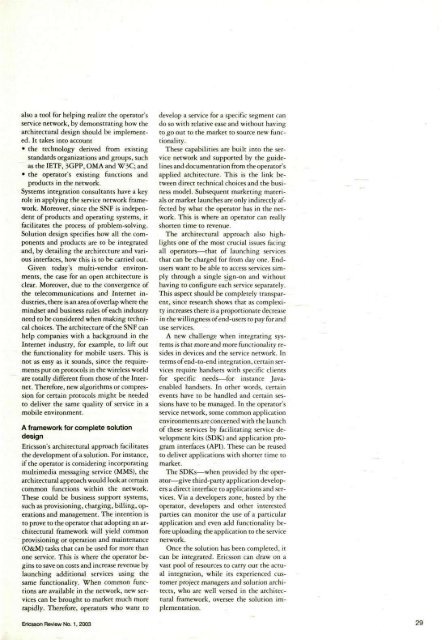ericssonhistory.com
ericssonhistory.com
ericssonhistory.com
- No tags were found...
You also want an ePaper? Increase the reach of your titles
YUMPU automatically turns print PDFs into web optimized ePapers that Google loves.
also a tool for helping realize the operator'sservice network, by demonstrating how thearchitectural design should be implemented.It takes into account• the technology derived from existingstandards organizations and groups, suchas the IETF, 3GPP, OMA and W3C; and• the operator's existing functions andproducts in the network.Systems integration consultants have a keyrole in applying the service network framework.Moreover, since the SNF is independentof products and operating systems, itfacilitates the process of problem-solving.Solution design specifies how all the <strong>com</strong>ponentsand products are to be integratedand, by detailing the architecture and variousinterfaces, how this is to be carried out.Given today's multi-vendor environments,the case for an open architecture isclear. Moreover, due to the convergence ofthe tele<strong>com</strong>munications and Internet industries,there is an area of overlap where themindset and business rules of each industryneed to be considered when making technicalchoices. The architecture of the SNF canhelp <strong>com</strong>panies with a background in theInternet industry, for example, to lift outthe functionality for mobile users. This isnot as easy as it sounds, since the requirementsput on protocols in the wireless worldare totally different from those of the Internet.Therefore, new algorithms or <strong>com</strong>pressionfor certain protocols might be neededto deliver the same quality of service in amobile environment.A framework for <strong>com</strong>plete solutiondesignEricsson's architectural approach facilitatesthe development of a solution. For instance,if the operator is considering incorporatingmultimedia messaging service (MMS), thearchitectural approach would look at certain<strong>com</strong>mon functions within the network.These could be business support systems,such as provisioning, charging, billing, operationsand management. The intention isto prove to the operator that adopting an architecturalframework will yield <strong>com</strong>monprovisioning or operation and maintenance(O&M) tasks that can be used for more thanone service. This is where the operator beginsto save on costs and increase revenue bylaunching additional services using thesame functionality. When <strong>com</strong>mon functionsare available in the network, new servicescan be brought to market much morerapidly. Therefore, operators who want todevelop a service for a specific segment cando so with relative ease and without havingto go out to the market to source new functionality.These capabilities are built into the servicenetwork and supported by the guidelinesand documentation from the operator'sapplied architecture. This is the link betweendirect technical choices and the businessmodel. Subsequent marketing materialsor market launches are only indirectly affectedby what the operator has in the network.This is where an operator can reallyshorten time to revenue.The architectural approach also highlightsone of the most crucial issues facingall operators—that of launching servicesthat can be charged for from day one. Enduserswant to be able to access services simplythrough a single sign-on and withouthaving to configure each service separately.This aspect should be <strong>com</strong>pletely transparent,since research shows that as <strong>com</strong>plexityincreases there is a proportionate decreasein the willingness of end-users to pay for anduse services.A new challenge when integrating systemsis that more and more functionality residesin devices and the service network. Interms of end-to-end integration, certain servicesrequire handsets with specific clientsfor specific needs—for instance Javaenabledhandsets. In other words, certainevents have to be handled and certain sessionshave to be managed. In the operator'sservice network, some <strong>com</strong>mon applicationenvironments are concerned with the launchof these services by facilitating service developmentkits (SDK) and application programinterfaces (API). These can be reusedto deliver applications with shorter time tomarket.The SDKs—when provided by the operator—givethird-party application developersa direct interface to applications and services.Via a developers zone, hosted by theoperator, developers and other interestedparties can monitor the use of a particularapplication and even add functionality beforeuploading the application to the servicenetwork.Once the solution has been <strong>com</strong>pleted, itcan be integrated. Ericsson can draw on avast pool of resources to carry out the actualintegration, while its experienced customerproject managers and solution architects,who are well versed in the architecturalframework, oversee the solution implementation.Ericsson Review No. 1, 200329















